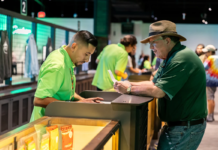Brands rely heavily on social media to raise awareness. With relatively low overhead costs and the potential for considerable reach, a robust social media strategy is crucial for sustainable growth. Compound that with the fact that nearly half of industry operators have an annual marketing budget of less than $50,000, it’s clear social media is a must.
But the relationship between cannabis and social media is fraught, filled with drama and intrigue at every twist and turn. Things seem to evolve on a daily basis, with each platform offering unique rules and attitudes toward the plant. One minute you’re going viral for an industry update on LinkedIn, and the next, your brand’s account is removed from Instagram for a seemingly innocuous post.
Censorship issues, lack of opportunity for paid ads, and risk of account deletion are just a few of the struggles cannabis companies face on social media in 2023. In fact, 85 percent of survey respondents in last year’s New Frontier Data/Cannabis Marketing Association report expressed some level of difficulty delivering their messaging to target audiences. And while some platforms have been easing restrictions, it’s still a challenge for cannabis brands to effectively market online.
“The current landscape of cannabis social media is still highly restricted but slowly improving,” said Lisa Buffo, founder and chief executive officer at the Cannabis Marketing Association. “Twitter has started to take cannabis ads and Google has relaxed its policies for CBD advertising. This is a positive sign, as these changes have happened prior to any substantial change in federal policy.”
At such a precarious moment for the cannabis industry, how can companies and content creators navigate the rough waters of social media marketing?
Twitter makes strides, but results are mixed
The cannabis community celebrated earlier this year when it was announced Twitter would begin approving some industry ads in the U.S. and Canada. Many brands believed it was a step in the right direction and that other social media platforms would follow suit.
However, advertising on Twitter has proved to be easier said than done for many brands. The requirement that accounts be Twitter Blue or Verified Organization, which enables a blue or gold check next to usernames, is cost-prohibitive for some brands. While the blue check may only cost $8 per month, the gold version is $1,000 per month, something many companies cannot justify.
Twitter also requires cannabis companies to be licensed in the states in which they operate and target adults 21 and older. The number of states available for targeting is limited and brands may only promote packaged goods.
Many brands have hesitated to begin deploying ads on Twitter, arguing it’s clear the platform has to work out kinks in the system before the return on investment is obvious. Instead, they opt to engage on the platform through posts and comments as a way to increase visibility.
Meta offers high risk and reward
When it comes to consumer awareness, Instagram is still the place to be. Despite parent company Meta’s disdain for cannabis, with abject censorship and bans on ads, 70 percent of the New Frontier Data/Cannabis Marketing Association survey respondents said Instagram is the most effective social media platform for their digital marketing goals.
“Meta still appears to be the biggest holdout, and cannabis Instagram accounts are still getting shadowbanned and shut down, but overall, the landscape appears to be trending in a more tolerant direction,” said Buffo.
Many cannabis content creators are going to great lengths to avoid censorship on Instagram. Limiting what types of images are used (including overt consumption or pictures of raw flower), using “c@nnabis,” “oui’d,” and “w33d” to dodge AI flags, and avoiding the use of certain hashtags are all seemingly common practices on the platform.
Meta does allow certain hemp companies to advertise on its platforms, but the policies are confusing, to say the least. Brands can advertise hemp but may not promote the sale of CBD; instead, companies are permitted to “educate, advocate, or give public service announcements related to hemp and related products.”
Therefore, brands must be exceedingly cautious when it comes to the content of their Meta ads if they want to avoid outright bans.
LinkedIn and Reddit still most cannabis-friendly platforms
With so many censorship issues on other platforms, cannabis companies continue to lean into LinkedIn. The professional social network has seemingly embraced the cannabis industry, and engagement continues to climb.
While this may spell success for companies operating a business-to-business sales model, consumer-facing brands may wonder how LinkedIn can work. But the fact is many people on LinkedIn outside of the cannabis industry follow cannabis content creators. Social media professionals recommend posting articles that appeal to cannabis-adjacent industries, such as agriculture and tech to broaden their reach.
Consumer-facing brands have also found a friend in Reddit. The “network of communities” has several cannabis subreddits that see impressive engagement from loyal members, and brands are allowed to join these conversations. Reddit also allows cannabis advertising in Canada, while certain CBD companies are permitted to run ads in the U.S.
“There’s an exciting future ahead…”
While the current state of social media may feel frustrating at times, there’s no doubt it comes with the territory of trying to grow an industry that remains illegal at the federal level. The roller coaster ride that is the cannabis market enjoys many highs and lows, something that continues to play out on social media.
“There is still a long way to go until cannabis content is able to live freely on social media,” said Buffo. “Social media algorithms remain mysterious and still appear to favor opinionated, click-bait type content. Cannabis accounts can perform well but still do not appear to get the reach that other industries and products get.”
Despite these digital marketing challenges, Buffo remains hopeful that change is imminent.
“Cannabis has never been more mainstream nor more accepted in recent history,” she said. “It’s been nine years since the first states implemented adult-use cannabis, and the stigma has lessened significantly since then. In relation to the rapid rise of mushrooms and psychedelics into our laws and conversation, cannabis is becoming even more normalized, and there’s an exciting future ahead.”










[…] a business, cannabis companies find themselves fighting an uphill battle. The stringent content censorship imposed by social media giants, particularly those under Meta’s umbrella, has created an […]
[…] loves smoking pot and posting online. There will likely be some challenges, including potential social media censorship, but for a creative cannabis content creator, the sky’s the limit with this […]
[…] clothing brands and lifestyle brands. We didn’t have cell phones, and we didn’t have social media like today. I learned a lot from […]
[…] all selling our personal and commercial brands every day with every interaction. That’s why social media is such a powerful tool: It allows us to stay in one another’s orbit, celebrating wins and offering support in authentic […]
[…] media hadn’t yet become a marketing must-have when the team at social media app MassRoots adorned mg’s first cover. Founded with a seed investment of $150,000, within two […]
[…] most powerful advertising channels of our generation. With no paid search results, no video ads, no promoted social media posts, and no display ads, the options for boosting content and driving exposure to consumers […]